
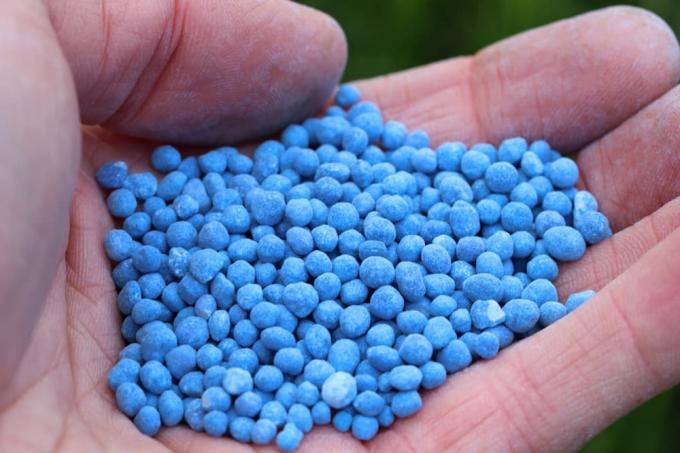
Table of contents
- Fertilizing deciduous trees - basics
- types of tree fertilizers
- Organic Fertilizers
- mineral fertilizers
- Function of individual ingredients
- Phosphorus (P)
- nitrogen (N)
- Potassium (K)
- when to fertilize
- Instructions for fertilizing
- Organic fertilizer
- Mineral fertilizer
- identify nutrient deficiencies
In nature, trees provide themselves with nutrients and thus maintain the nutrient cycle. In the garden, the conditions for this are usually not given, either because the soil is too poor or there is competition from other trees. Deciduous trees are divided into ornamental trees and fruit trees.
Fertilizing deciduous trees - basics
Deciduous trees can take on different functions in the garden, whether as shade providers, privacy screens, ornamental or fruit trees. In addition to the main nutrients nitrogen, phosphorus and potassium, all woody plants also need minerals and trace elements in sufficient quantities. Factors that influence the respective nutrient requirements are the tree species, location, soil conditions and size of the tree, lighting conditions and weather. Trees with a greater rooting depth can absorb significantly more nutrients. In nature, important nutrients are added to the soil through weathering processes. This creates a natural nutrient cycle.
This could also work in the garden, but this process is often disrupted here. This is partly due to the fact that falling leaves are regularly removed in many cases, so that no rotting can take place on the spot and important nutrients are lost. These must then be compensated with an appropriate tree fertilizer.
types of tree fertilizers
There are basically two different fertilizers, the organic and the mineral fertilizers:
Organic Fertilizers

Organic fertilizer is created through the decomposition of naturally occurring organic matter. Plant nutrients, which are initially withdrawn from the soil for the growth of the plants, are fed back into it after they die, the natural cycle continues to close.
- Very good organic fertilizers are compost, stable manure and plant manure
- Rock flour, horn shavings and horn meal are also well suited
- Compost contains all important nutrients and trace elements
- Rock flour consists of ground rock flour
- Horn shavings and horn meal are waste products from animal production
- The effect of organic fertilizer only begins after the substances have decomposed
- It acts more slowly, but over a longer period of time
- Over-fertilization is less common
Tip:
Organic tree fertilizers should always be preferred to mineral fertilizers. They are more environmentally friendly and can avoid damage to health when eating fruit due to improper use of mineral fertilizers.
mineral fertilizers
Despite the positive properties of organic tree fertilizers, there are quite a few fans of mineral fertilizers among hobby gardeners. The nutrients contained are available to plants more quickly because they are more easily and quickly soluble. Results are visible after a short time. However, the dosage is often not optimal. This leads to over-fertilization, which has a lasting impact on the environment, because the soluble components are also flushed into the groundwater.
Exclusive use of mineral fertilizers, also known as artificial fertilizers, can weaken important soil organisms, so that the soil is no longer sufficiently aerated. The consequences are erosion damage and soil compaction. When used as tree fertilizer, residues can accumulate in the ripe fruit, especially in fruit trees, and thus enter the food chain. In addition, an excess of nitrogen can reduce yields.
Damage caused by over-fertilization can also be observed on other deciduous trees. Foliage may turn yellow, it burns. In addition, affected plants are generally much more susceptible to frost damage, pests and diseases. Despite everything, mineral fertilizers can also provide deciduous trees with all the important nutrients, as long as the dosage is right. Commonly used fertilizers are e.g. B. Blue grain, lime, calcium ammonium nitrate or so-called NPK fertilizers.
Tip:
In addition to these types of fertilizers, there are also organic-mineral fertilizers, a mixture of both. However, they do not offer any advantages over purely organic or purely mineral tree fertilizers.
Function of individual ingredients
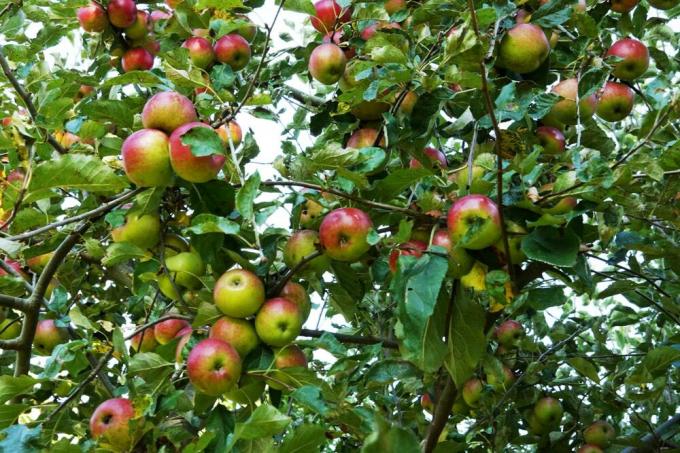
Trees can only develop many new shoots, flowers or fruits if they are adequately supplied with all the necessary nutrients. The most important elements in both organic and mineral fertilizers are nitrogen, phosphorus and potassium. In addition, minerals such as sulphur, calcium and magnesium and trace elements such as iron, manganese, copper and zinc are required. Each of these elements fulfills a specific function for the metabolism of the tree. They are in direct interaction with each other and should always be present in the soil in a balanced ratio.
Phosphorus (P)
- Phosphorus-rich fertilizers are best suited for fruit trees that are both flowering and bearing fruit
- Phosphorus promotes development of flowers, fruits and seeds
- Supports the formation of healthy and strong roots
- Required by flowering and fruiting deciduous trees
- Excessive levels of nitrogen in the soil can impede the uptake of phosphorus
- Too much phosphorus leads to growth disorders
- It hinders the absorption of important trace elements
- Optimum phosphorus content recognizable in rich blossoms, fruit setting and fruit ripening
nitrogen (N)
Nitrogen primarily stimulates the growth of green plant parts. In principle, nitrogenous fertilizers, so-called 'green manure', are suitable for trees where the foliage is particularly important. The nitrogen used in mineral tree fertilizers is usually produced synthetically. A lack of nitrogen stuns growth and leaves leaves turn pale green or yellow. An excess of nitrogen leads to soft, unstable tissue and masty leaves. It usually also involves increased exposure to nitrates. An optimal proportion of nitrogen in the soil is reflected in normal growth and lush green foliage.
Potassium (K)
Potassium is a natural component of soil. It ensures the formation of a stable plant structure, promotes the formation of roots, tubers and fruits and their firmness. It is also needed for the transport of water and nutrients and makes the plants more resistant to frost and pests. An undersupply of potassium leads to a wide variety of deficiency symptoms such as growth disorders, wilted, limp and discolored leaves and increased susceptibility to Diseases. Too much potassium can stunt growth and cause root burns, leaf damage and stunted growth. If the tree looks healthy, grows stably and quickly, the potassium content is ideal.
when to fertilize
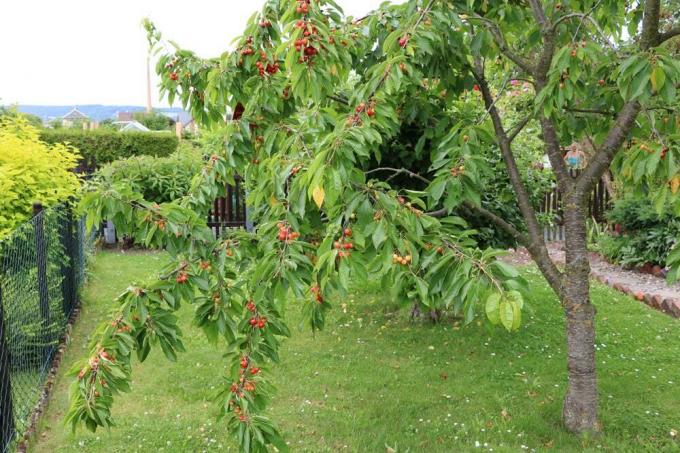
Deciduous trees use their fallen leaves to provide themselves with all the important nutrients. You can help them by using a rake to spread surrounding leaves on the tree disc and a little beyond. Microorganisms in the soil do the rest. When fertilizing deciduous trees, less is more.
- Don't necessarily fertilize deciduous trees every year
- Every two years is sufficient
- Only fertilize during the growing season
- At the beginning of the shoot in March/April and at the end of the shoot around the 24th June
- Effect of organic fertilizers is delayed
- A lead time of 3 – 4 weeks is recommended
- Depending on the moisture content and temperature of the soil
- Mineral fertilizers are water soluble and immediately available to plants
In autumn and winter, during the rest period, no fertilizer is used at all, because then the plants do not absorb any nutrients. If you still fertilize at other times, you risk that the plants will not mature. The soft shoots are sensitive to frost and can be damaged. The frequency and timing of fertilization also depend on the age of the tree.
Young trees that were provided with compost when planted do not need additional fertilizer this year. The compost provides it with all the important nutrients in the first year. A thick layer of mulch on the root zone prevents competition from other plants that could rob the tree of nutrients.
Instructions for fertilizing
Before you start fertilizing, it is advisable to determine the actual nutrient requirements by means of a soil analysis in the area of the tree disc. Once the result is certain, one should first consider that the root system of a deciduous tree is usually always is slightly wider than the crown, so that fine, so-called suction roots can also be found outside the crown eaves condition.
If the tree disc is not overgrown or open, you can spread a thin layer of fertilizer over the entire area and again a little further. Then you work it lightly into the ground with a rake. A layer of mulch is then spread over this, which should be renewed every year.
In order to fertilize deciduous trees that grow in the lawn or in a meadow, it usually makes no sense to simply sprinkle the fertilizer on. It should be planted below the turf by making small holes in it with a lawn aerator regularly on the tree disc, bringing in the fertilizer and watering it if necessary falls asleep
If possible, fruit trees should not be in the lawn or in the meadow, without an open tree grate the food competition from the grasses is very strong, especially for young trees. In addition, it should never be applied to dry soil, as this would burn the roots. Depending on the type of fertilizer, it is better to apply them after a downpour or with the irrigation water.
Tip:
For a corresponding soil analysis, it is advisable to always take samples from different parts of the tree disc in order to obtain a representative result. Such soil analyzes should be repeated about every 4 - 5 years.
Organic fertilizer

Deciduous trees that do not bear fruit can largely provide themselves with nutrients through the shedding of leaves in autumn. Fruit trees have a slightly higher nutrient requirement. If you leave fallen fruit, especially on fruit trees, this is also a natural fertilizer. For many hobby gardeners, compost is the best organic fertilizer.
- Spread fresh or mature compost on tree discs every 3 – 5 years
- Work lightly into the soil
- If necessary, add some rock flour
- Add a layer of mulch to the compost
- Lawn clippings, bark mulch or wood chips are suitable
- Apply 100 - 140 g of a nitrogen fertilizer to stone fruit trees
- For pome fruit, 70 – 100 g per tree is sufficient
- For young plants, reduce the amount of fertilizer by about 75%
- Some wood ash can increase potassium levels in the soil
- Supply important trace elements with algae lime or rock flour
Compost is less suitable as a fertilizer for lime-sensitive deciduous trees such as rhododendrons, dogwoods or magnolias. Another good organic fertilizer is manure, in the form of horse, sheep, cattle, rabbit, or chicken manure. It should be noted here that manure should never be applied fresh, but only well rotted. It should be spread over the affected area and buried shallow about every three years in the fall. Incidentally, cattle manure is also available in the form of pellets.
Tip:
Before spreading bark mulch, you should ensure a good nitrogen supply, because bark mulch in particular removes a lot of nitrogen from the soil. It therefore makes sense to mix the compost with horn shavings or horn meal (nitrogen fertilizer) to avoid undersupply.
Mineral fertilizer
With mineral fertilizers, larger deficits in the soil can be compensated for relatively quickly. Although they do not create humus, they still provide the trees with all the necessary nutrients. The main problem here is the right dosage, so that it can quickly lead to oversupply or oversupply. Over-fertilization comes, which does more harm than good to the tree.
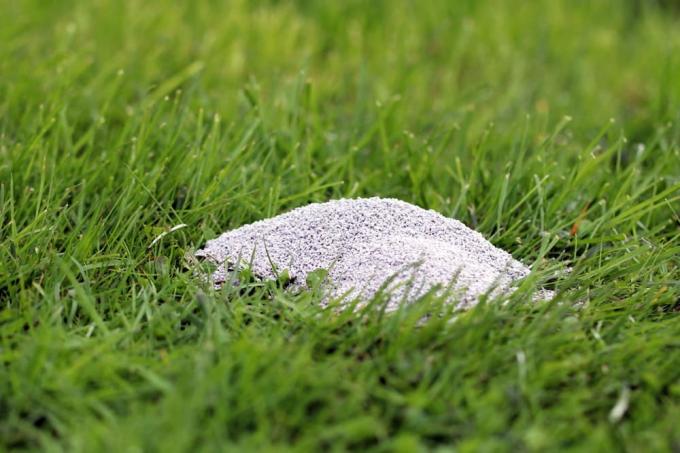
The most common mineral fertilizers for deciduous trees, especially fruit trees, are calcium ammonium nitrate and blue grain. These fertilizers are best applied to the soil in two separate applications. Usually 15 - 20 g of the fertilizer is sufficient. The need of older trees is somewhat higher. Amounts of 50 – 60 g are recommended here.
Tip:
Anyone who opts for a mixture of organic and mineral fertilizers should use a nitrogen-rich complete fertilizer if possible.
identify nutrient deficiencies
Signs of a nutrient deficiency can be, for example, declining growth. If leaves noticeably lose color and lighten more and more, this can indicate chlorosis. This is usually caused by a lack of mineral nutrients such as magnesium and iron. But there are also plants, so-called indicator plants, which indicate an existing deficiency. These include the stinging nettle, whose occurrence is particularly high on very nitrogen-rich soils. On the other hand, arthropod and chamomile can be signs of a nitrogen deficiency.
Wood sorrel, horsetail and bracken thrive on lime-poor soils. Heather, meadow sorrel and daisies love nutrient-poor soils. In order to be sure whether there is a deficiency or an excess, there is no way around a corresponding soil analysis, which ideally should be repeated every few years.
 garden editorial
garden editorial I write about everything that interests me in my garden.
Learn more about fertilizing
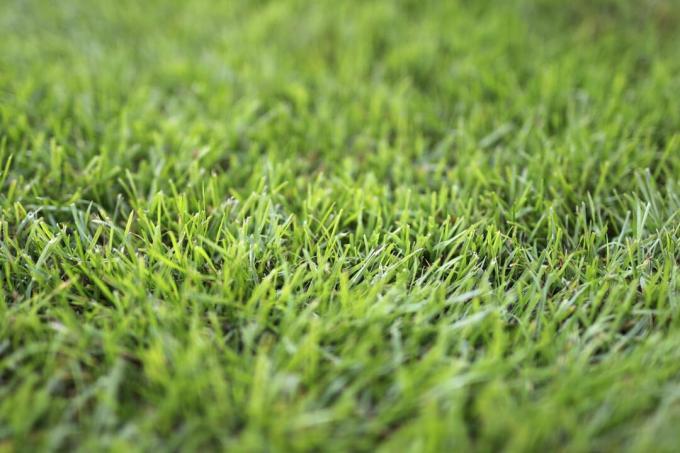
Make effective nitrogen fertilizers yourself lawn fertilizer
In order to develop optimally, plants need sufficient nutrients. For example, nitrogen, one of the main nutrients, is indispensable. If this is not present in sufficient quantities in the soil, satisfactory growth cannot take place. As a result, it must be delivered.
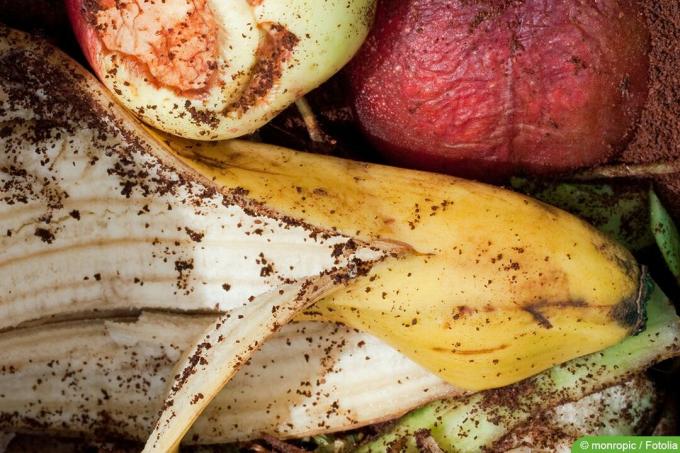
Dried banana peel as fertilizer | Application tips
Bananas are popular and healthy. The banana peel usually ends up in the trash. But it is far too good for that, because the dried shells are an excellent fertilizer for a variety of garden plants.

Horn meal: with fertilizer against clover in the lawn | 7 tips
In the lawn, clover is usually undesirable. With too little fertilization, however, it spreads quickly. Horn meal can help as a biological fertilizer. See this article for tips on how to use it.

Unusual Fertilizers | 13 home remedies that can do more
Much of what accumulates in the household and usually ends up in the organic waste bin can be used to fertilize garden and/or indoor plants. They offer an ecological alternative to mineral fertilizers and score with environmental compatibility and sustainability.

Fertilizer for roses: 15 home remedies for fertilizing roses
In addition to rose fertilizer, numerous home remedies are also suitable as nutrient suppliers for roses. We present the most popular ones in this article!

Fertilize properly | What good is low-nitrogen fertilizer?
No plant can survive without nutrients. Only with optimal and needs-based care can they develop magnificently, bloom lavishly and bring rich harvests. As a result, fertilizer plays an important role in care, provided the ingredients and dosage are right.
